You just don’t know what you’re going to see next at Dan Robinson’s Elandan Gardens, in Bremerton, WA, but you can bet it’s been around a while. Or, at least it will look that way. The Japanese larch below is younger than I am, grown from seed since 1974. Robinson planted this tree on a lava rock years ago, but over time, most of the soil has washed away. Robinson actually picked the tree up to show me the shallow root ball and marveled that the tree could withstand the high temperature the rock reached on sunny days.
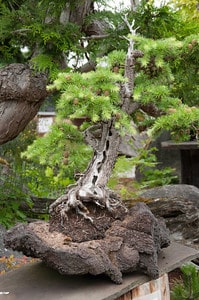
Japanese Larch – Laryx loptoleptis
Year of origin: 1974
Grown from a seed, this tree was field grown by John Hinds. When The Colonel donated the tree in 1997, I decided to train it as a hollow windswept tree on a rock. Carving, wire training and planting the tree on the lava stone was achieved in 2001. (Caption: Elandan Gardens)
The hemlock below is far older. Planted in an ornate unglazed pot, the hemlock is thriving in the cool Pacific Northwest summer.
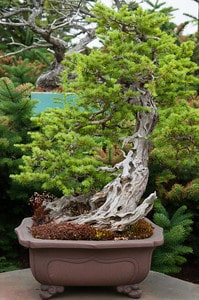
Alpine Hemlock – Tsuga mertensiana
Collected in 1997 from an alpine area on Vancouver Island. Heavily carved and wire trained in 2003. This splendid tree has been selected as the logo tree for the Evergreen Bonsai Club of Kitsap County. (Caption: Elandan Gardens)
Hailing from the opposite end of the US, several Bald Cypress were doing just as well.
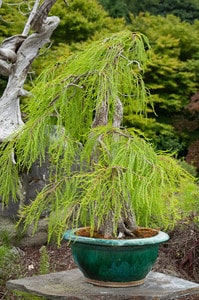
Bald Cypress – Taxodium distichum
This naturally hollow-trunked beauty came from deep in Florida and was collected in March of 2004. Because of a healthy root system it never seemed to know it was uprooted and flown to its new home at Elandan Gardens. The growth was vigorous in 2004 and the future for this plant is promising. It is planted in an antique Chinese pot, circa 1835. (Caption: Elandan Gardens)
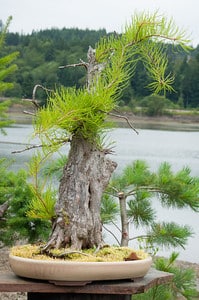
Bald Cypress
A small number of Elandan’s trees were imported from Asia, including the Korean hornbeam below. The trunk shows that deciduous trees can also convey great age.
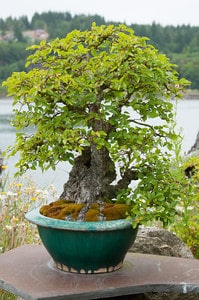
Korean Hornbeam – Carpinus koreanensis
This tree was collected from the mountains of Korea in the 1980s. It was reduced from its original 12-foot height. The new sprouts, which issued form the remaining trunk and base, were trained into its basic form. I acquired the tree from Brussell’s Bonsai Nursery in 1991. Carving was done to eradicate the large pruning scars left over from its initial reduction. Careful pruning and wiring has lead to its now aged yet elegant form. (Caption: Elandan Gardens)
One of my favorite trees in the garden is somewhat of a rarity – a big cone Douglass Fir bonsai. The trunk movement and deadwood are great.
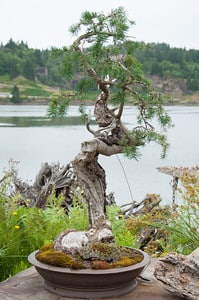
Big Cone Douglas Fir – Pseudotsuga macrocarpa
Collected in the Colorado Rockies in 2009. Untrained at present, its extraordinary trunk speaks to a life of durability in the face of adversity. Life followed by death is evidenced by the successive layers seen here on the trunk. (Caption: Elandan Gardens)
A number of chamaecyparis found their home in Elandan, including the yellow-foliaged specimen below.
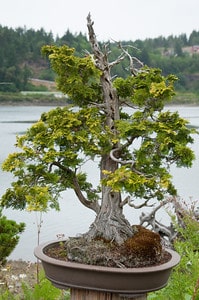
Chamaecyparis family
Elandan’s trees are planted in a variety of containers, from Japanese and Chinese stoneware, to stones, to containers made by local potters. The pot below, as well as several similar pots at Elandan, was made by Oregon potter Charles Gloucester.
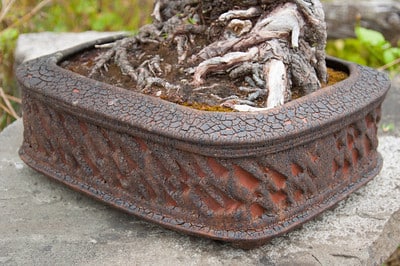
Charles Gloucester pot
The last tree I saw before leaving the garden was an awesome collected hemlock that defies stylistic categorization. I can’t wait to see what shape it takes after its initial styling.
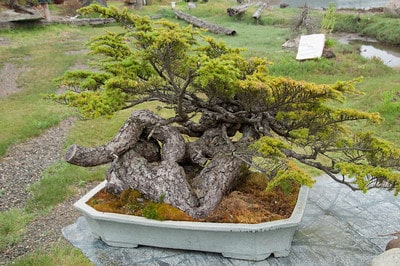
Hemlock
Subscribe to Bonsai Tonight
New Posts Delivered Every Tuesday and Friday
Chase says
Any Bonsai person going to the U.S. North West should stop at Elandan Gardens to see a life time of collecting and Dans ability to make trees look old. Better yet read his book Gnarly Branches, Ancient Trees
Chase
Mac says
Great photos Jonas and beautiful subjects.
I believe the two trees identified as bald cypress are actually pond cypress.
Jonas Dupuich says
Thanks mac – that very well could be. I went by the signs posted at the garden but the leaves do look a lot like pond cypress.
ang3lfir3 says
I am so glad you enjoyed your stroll through the garden. As one of Daniel’s devoted students (sadly I was not there the day you arrived) I am always delighted when some one can really get excited about what they are seeing and spend some time just enjoying the trees.
Having worked on the large hornbeam above this year (wiring every branch) I can attest that the trunk is indeed aged … the magic of such interesting trees is one of the best parts of the experience.
I hope you come back again sometime soon, hopefully I will get the chance to chat.
nakatsukuni says
Thanks for sharing. Beautiful.
Regarding the very nice hemlock material at the end, if you’re actually waiting for ”initial styling,” you’re waiting for a train won’t come. As demonstrated by the rest of the trees you saw there, Dan won’t style it. He’ll remove branches that don’t fit with his idea, but ”styling” is not a word in Dan’s bonsai vocabulary. He trims and leaves the tree to its own devices.
Also, this is not bonsai. It is pot culture gardening with trees. I do not mention this as criticism, but as a plain statement of obvious fact. What Dan does (what Dan let’s happen) is beautiful to behold. It is also something entirely different from what bonsai artists do. Let us not confuse these.
Bonsaizoo says
WOW! Rude and can’t read an entire post. (nakatsukuni)
Garth says
Really great to see some infrequently cultivated species depicted, the effort that went into developing these works of art is astounding!
In regards to the specimen labeled as bigcone Douglas-fir, if this plant was collected in Colorado, it is very probably Pseudotsuga menziesii rather than the California endemic P. macrocarpa.